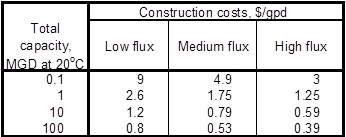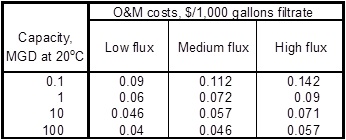COSTS
As of this date, one of the most detailed discussion of the costs of microfiltration (MF)Microfiltration (MF) membranes: Microfiltration membranes are typically hollow-fibers with a pore size range of approximately 0.1 – 0.2 μm (nominally 0.1 μm). and ultrafiltration (UF)Ultrafiltration (UF) membranes: Ultrafiltration membranes are typically hollow-fibers with a pore size range of approximately 0.01 – 0.05 μm (nominally 0.01 μm). membrane systems is AWWA's "Microfiltration and Ultrafiltration Membranes for Drinking Water" (AWWA 2005). The cost graphs from this document were also presented in the 2008 AWWA subcommittee report on MF and UF systems (AWWA 2008). The construction costs and operation and maintenance costs (O&M) for MF and UF facilities will of course be site specific. For example, a submerged vacuum systemVacuum systems: Vacuum membrane systems are microfiltration or ultrafiltration systems in which the membranes are immersed in a tank of water and a vacuum applied to pull the water through the membrane. may be much more expensive if the construction of new tanks is required in order to hold the submerged membranes, but if the membranes can be retrofitted into existing tanks at a current facility, then the costs will most likely be much less. Moreover, O&M costs will vary according to raw water quality, local electricity costs, etc. Thus, general cost information such as presented here must be considered approximate, and there may be significant differences for any specific facility.
The AWWA document (2005) referred to above presented data on equipments costs (membrane equipment only), construction costs (membrane equipment as well as other equipment plus construction costs), and O&M costs for MF and UF membrane water treatment plants. Note that if pilot testingPilot testing: Pilot testing is the use of treatment units significantly smaller than the full scale plant but which would mimic the treatment of the full scale plant in order to determine design and operational factors. is performed, then the costs of pilot testing in 2005 dollars could be in the range of $50,000-$100,000 per unit tested if the utility does the day-to-day monitoring and operation. These costs include equipment rental ($2,500-$5,000/mo), setup, labor, supplies, water quality testing, etc. The construction and O&M cost estimates developed in the 2005 AWWA report assumed a project planning horizon of 20 years and 6% interest rates and are in 2003 dollars. The capital costs which were considered to be accurate to ±25% include feed waterFeed water: The feed water is the water stream applied to the membrane unit., strainers, membrane units, backpulseBackpulse or backwash: 1) Backwash is a procedure in which periodically the flow direction is reversed through the membrane for a short period of time in order to remove particulates accumulated at the membrane surface. 2) Backwash also refers to the waste water produced as a result of the backwash procedure. equipment, process air, compressed air, chemical washing, clean-in-placeClean-in-place (CIP) or in-situ chemical cleaning: Clean-in-place is a procedure performed periodically to clean a membrane more thoroughly than backwashing can achieve in order to restore the permeability of the membrane towards baseline levels. The process uses chemicals such as citric acid and chlorine or others to remove accumulated foulants on the membrane., electrical equipment, SCADASCADA: SCADA is an acronym of Supervisory Control and Data Acquistion. The term refers to computer systems including programmable logic controllers (PLCs) used to monitor and control water treatment processes and distribution systems including storing data and displaying the status of systems and historical trends., and various ancillary equipment but not residualsResiduals: Residuals refers to all waste streams from a treatment process. For membrane systems it could include the backwash wastewater, clean-in-place wastewaters, rinse waters, and concentrates. disposal, land acquisition/development nor intake structures nor storage. The O&M costs were also considered to be ±25% and include energy costs, chemicals, and membrane replacement, but not equipment maintenance and repair (typically $0.02-$0.04/1,000 gal), waste disposal, nor labor. The AWWA documents did not provide equations for the cost curves to allow estimates or reproduction of the figures but the table below summarizes some of the cost estimates read from the AWWA graphs.
Although the costs are reported in 2003 dollars, the equivalent 2010 costs should be approximately 37% higher based on the composite Civil Works Construction Cost Index published by the U.S. Army Corps of Engineers. These costs data have the benefit of breaking out costs according to whether the membranes are loaded at high fluxFlux: Flux is the flow rate of water applied per unit area of the membrane and has units of volume/unit area/time., medium flux, or low flux since the flux significantly affects cost. However, no specific information was given for the ranges of flux in high, medium or low but rather was stated to be dependent on the manufacturer.

MF/UF membrane filtration facility construction costs ($2003)

MF/UF membrane filtration facility O&M costs ($2003)
Movahed (2010) estimated MF/UF capital costs of 0.6 – 1.2 $/GPD capacity and O&M costs of 0.3-0.4 $/Kgal with overall water costs of 0.4-0.6 $/Kgal. These costs include all equipment, piping, controls, membrane replacement, chemicals and power but do not include building, site work, and finished water pumping. These capital costs are in line with AWWA's document (2005) but the O&M costs are higher.
In comparison, Braker (2010) reported data for an immersed vacuum GE ZeeWeed® system in Tennessee as:
• Power Use = 0.08-0.12 KW/1000 gal
• Power Cost = $0.0033-$0.0052/1000 gal
• Chemical Cost = $0.0031/1000 gal
• Maintenance Cost = negligible
• Total Membrane Operating Cost < $0.01/1000 gal
• Membrane Capital Cost ~ $0.056/1000 gal
• Building Construction ~ $0.032/1000 gal
• Total Membrane Filtration cost < $0.10/1000 gal











